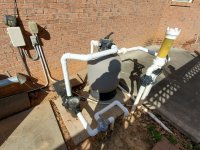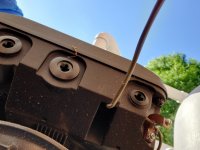Hello,
I have a JANDY VSFHP185DA2A pump with the iQPUMP01 mobile interface. This was installed last year by a pool company, but the installation was never completed. The iQPUMP01 is just loose and the RS485 cable is just sitting on the ground.
I'd like to scope out installing this properly and installing a SWCG at the same time.
The Jandy TruClear Salt Chlorinator seems to be a logical choice for my setup.
 www.jandy.com
www.jandy.com
So here are the objectives:
- Run conduit to the VSFHP185DA2A for the RS485 link(s)
- Upgrade circuit to GFCI
- Install SWCG
- Clean, professional installation
Here are the assumptions:
1) The Jandy TruClear Salt Chlorinator is a good choice for my system
2) The SWCG should be installed there where the chlorinator is
Here are the questions:
1) Should I install a panel for the iQPUMP01 and/or SWCG controller? Or just mount them directly to the brick? Any panel recommendations?
2) It looks like the current RS485 cable is just hanging out of the bottom of the pump. How would conduit be attached there? The power lines are in conduit and should remain separate.
3) Can the SWCG be on the same circuit as the pump? The pump is wired for 240 V but I have the 120 V neutral in that timer panel. The breaker panel is maxed out.
4) I've read the TruClear manual but it isn't clear how to connect both it and the iQPUMP01. Would you daisy chain them together in the panel? Or is there a second RS485 home run from the TruClear to the pump?
5) Should I remove the leftover timer from the fixed speed pump (there in the panel under the iQPUMP01)? I believe it is basically acting as a terminal strip for the pump power connections. Maybe best to leave it be?
6) Can you even purchase a TruClear without going through a Jandy dealer?


I have a JANDY VSFHP185DA2A pump with the iQPUMP01 mobile interface. This was installed last year by a pool company, but the installation was never completed. The iQPUMP01 is just loose and the RS485 cable is just sitting on the ground.
I'd like to scope out installing this properly and installing a SWCG at the same time.
The Jandy TruClear Salt Chlorinator seems to be a logical choice for my setup.
Salt Water Pool Chlorinator: Jandy TruClear | Jandy
Looking for a Salt Water Pool Chlorinator? Find the Jandy TruClear for the Perfect Pool Experience. Buy Now w/ a Pool Pro Near You!
 www.jandy.com
www.jandy.com
So here are the objectives:
- Run conduit to the VSFHP185DA2A for the RS485 link(s)
- Upgrade circuit to GFCI
- Install SWCG
- Clean, professional installation
Here are the assumptions:
1) The Jandy TruClear Salt Chlorinator is a good choice for my system
2) The SWCG should be installed there where the chlorinator is
Here are the questions:
1) Should I install a panel for the iQPUMP01 and/or SWCG controller? Or just mount them directly to the brick? Any panel recommendations?
2) It looks like the current RS485 cable is just hanging out of the bottom of the pump. How would conduit be attached there? The power lines are in conduit and should remain separate.
3) Can the SWCG be on the same circuit as the pump? The pump is wired for 240 V but I have the 120 V neutral in that timer panel. The breaker panel is maxed out.
4) I've read the TruClear manual but it isn't clear how to connect both it and the iQPUMP01. Would you daisy chain them together in the panel? Or is there a second RS485 home run from the TruClear to the pump?
5) Should I remove the leftover timer from the fixed speed pump (there in the panel under the iQPUMP01)? I believe it is basically acting as a terminal strip for the pump power connections. Maybe best to leave it be?
6) Can you even purchase a TruClear without going through a Jandy dealer?


Last edited:

